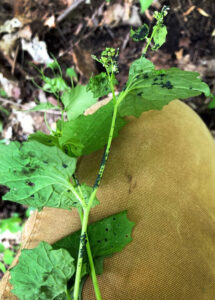By Erika Segerson-Mueller, DNR Invasive Plant Program Specialist, Oshkosh Service Center;
Erika.SegersonMueller@wisconsin.gov or 715-492-0391

Leaves appear wrinkled and less healthy in garlic mustard plants affected by aphids. / Photo Credit: Rebecah Troutman, Holden Forests and Gardens, Bugwood.org
The NR40-restricted invasive plant garlic mustard (Alliaria petiolata) is prevalent in many Wisconsin woodlands, but a new wave of hope is on the horizon.
The garlic mustard aphid, a tiny, dark, gray-to-green insect sometimes called the “grenade” aphid after the pattern of raised blotches on its back, was found in 2021 at the Holden Arboretum in Ohio. It could become a viable form of biocontrol for the garlic mustard plant.

A close-up photo of garlic mustard aphids (Lipaphis alliariae) on a garlic mustard leaf. / Photo Credit: Rebecah Troutman, Holden Forests and Gardens, Bugwood.org
Aphids are sap suckers, using their piercing mouthparts to feed on the leaves, stems and roots of plants, weakening them. While the aphids are small, they can be located by looking for garlic mustard plants with twisted seed pods and wrinkled leaves.
Since its discovery, Holden Forests and Gardens has been leading the charge, researching the aphid and spreading information to determine its distribution.
What Is Biocontrol?
Biocontrol, or biological control, is an alternative to mechanical and chemical treatments for pest populations. An objective for invasive plant control is to reunite the plant with an insect or pathogen enemy that naturally occurs in the plant’s native range. When paired with a natural enemy, invasive plants can become less competitive. Specific biocontrol options require stringent testing and an intensely regulated approval process before being made available.
In North America, few insects eat garlic mustard. The garlic mustard aphid found in Ohio is native to Europe and specifically feeds on garlic mustard in its native range. It is uncertain how the pest was introduced to America. Garlic mustard plants with aphids on the leaves appear less healthy; leaves wrinkle, and the plants’ usually straight seed pods become twisted.
Report And Stay In The Know

A second-year garlic mustard plant has a tall flowering stem with small white flowers and triangular leaves. / Photo Credit: Wisconsin DNR
Rebecah Troutman of the Holden Arboretum is continuing to research infested plants, focusing on the seeds. Current research includes testing whether the seeds of infested plants are less likely to result in new plants than seeds from uninfested plants. This research will inform the impacts of the aphid on garlic mustard and the possibility of the aphid acting as a natural biocontrol agent in the future.
Stay tuned to the Holden Forests and Gardens webpage to get aphid updates throughout the field season, and download the EDDMapS application to report garlic mustard aphid sightings in your region.
Learn more about using EDDMapS for reporting in the “Be On The Lookout” for garlic mustard aphids brochure created by the Midwest Invasive Plant Network and Holden Forests and Gardens.
